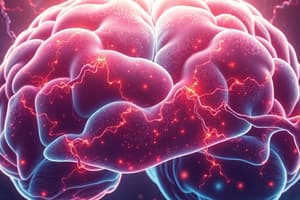Podcast
Questions and Answers
Which receptor type is primarily responsible for increasing heart rate and contractility?
Which receptor type is primarily responsible for increasing heart rate and contractility?
- Alpha 1
- Beta 1 (correct)
- Beta 2
- Alpha 2
What effect does the activation of alpha 2 receptors have on neurotransmitter release?
What effect does the activation of alpha 2 receptors have on neurotransmitter release?
- Increases norepinephrine release
- Decreases norepinephrine release (correct)
- Has no effect on neurotransmitter release
- Stimulates acetylcholine release
Which adrenoceptor type is most effective in mediating bronchodilation?
Which adrenoceptor type is most effective in mediating bronchodilation?
- Beta 1
- Alpha 1
- Alpha 2
- Beta 2 (correct)
Based on the agonist potency order, which adrenoceptor type would have the highest response to exogenous catecholamines?
Based on the agonist potency order, which adrenoceptor type would have the highest response to exogenous catecholamines?
Which of the following statements correctly describes the effects of alpha 1 receptor activation?
Which of the following statements correctly describes the effects of alpha 1 receptor activation?
What impact do Beta 1 receptors have on the heart?
What impact do Beta 1 receptors have on the heart?
What occurs as a result of vasoconstriction mediated by Alpha 1 receptors?
What occurs as a result of vasoconstriction mediated by Alpha 1 receptors?
How do feedback mechanisms affect blood pressure in response to norepinephrine infusion?
How do feedback mechanisms affect blood pressure in response to norepinephrine infusion?
What role does Tyrosine Hydroxylase play in noradrenaline synthesis?
What role does Tyrosine Hydroxylase play in noradrenaline synthesis?
Which of the following mechanisms is NOT involved in the termination of norepinephrine action?
Which of the following mechanisms is NOT involved in the termination of norepinephrine action?
Which adrenergic receptor primarily causes skeletal muscle tremors?
Which adrenergic receptor primarily causes skeletal muscle tremors?
What is the effect of activation of Alpha 2 receptors in the pancreas?
What is the effect of activation of Alpha 2 receptors in the pancreas?
Which factor is NOT influential in the potency of adrenergic agents?
Which factor is NOT influential in the potency of adrenergic agents?
Which action is associated with Beta 2 receptors in the body?
Which action is associated with Beta 2 receptors in the body?
What is a likely outcome of norepinephrine's action on presynaptic receptors?
What is a likely outcome of norepinephrine's action on presynaptic receptors?
Which adrenergic receptor subtype is primarily associated with inhibitory presynaptic activity?
Which adrenergic receptor subtype is primarily associated with inhibitory presynaptic activity?
What physiological effect occurs due to beta1 receptor stimulation in the heart?
What physiological effect occurs due to beta1 receptor stimulation in the heart?
Which action is directly attributed to alpha2 receptor activity?
Which action is directly attributed to alpha2 receptor activity?
What effect does general stimulation of metabolic activity have on the body?
What effect does general stimulation of metabolic activity have on the body?
Epinephrine demonstrates selectivity for which adrenergic receptors?
Epinephrine demonstrates selectivity for which adrenergic receptors?
Which of the following drugs is a selective agonist for alpha2 receptors?
Which of the following drugs is a selective agonist for alpha2 receptors?
Which physiological response is most influenced by beta2 agonists?
Which physiological response is most influenced by beta2 agonists?
What is the expected cardiovascular response to activation of beta1 receptors?
What is the expected cardiovascular response to activation of beta1 receptors?
Flashcards are hidden until you start studying
Study Notes
Adrenergic Receptors
- Alpha 1 receptors cause vasoconstriction in most vascular smooth muscles, contract the pupillary dilator muscles, and contract the genito-urinary sphincter.
- Alpha 2 receptors inhibit neurotransmitter release (NA and Ach), inhibit insulin secretion in the pancreas, and stimulate platelet aggregation.
- Beta 1 receptors increase heart rate and cardiac force of contraction, and stimulate juxtaglomerular cells.
- Beta 2 receptors relax respiratory, uterine, and vascular smooth muscles, stimulate glycogenolysis in the liver, and cause tremor in skeletal muscle.
- Beta 3 receptors cause lipolysis in fat cells.
Adrenergic Transmission
- The synthesis of norepinephrine is regulated by tyrosine hydroxylase, which is only found in catecholamine-containing cells.
- Dopamine beta-hydroxylase is an enzyme involved in the synthesis of norepinephrine, and it is mainly found in the adrenal medulla.
- The termination of released norepinephrine occurs through reuptake into adrenergic nerve terminals (neuronal), uptake into post-synaptic cells (extraneuronal), and metabolic degradation.
Potency
- Drug potency is significantly affected by several key factors. These include the drug's affinity for adrenoceptors, which determines how strongly the drug binds to these receptors. Efficacy on adrenoceptors refers to the drug's ability to activate these receptors effectively. Additionally, the drug's interactions with neuronal uptake systems play a crucial role, as do its interactions with monoamine oxidase (MAO) and catechol-O-methyltransferase (COMT), which are enzymes involved in the breakdown of catecholamines.
Adrenergic Agonists
- Phenylephrine is a selective agonist that has a high affinity for alpha 1 receptors. This means it specifically targets these receptors, which play a crucial role in the sympathetic nervous system's response to stress, particularly in vasoconstriction, leading to an increase in peripheral vascular resistance. As a result, phenylephrine is commonly utilized in clinical settings to raise blood pressure in patients experiencing hypotension, especially during surgical procedures or severe allergic reactions where blood pressure may drop dangerously low.
- Methyldopa is a selective agonist that targets alpha 2 receptors in the central nervous system. It acts as an antihypertensive agent by decreasing sympathetic outflow from the central nervous system, which leads to a reduction in peripheral vascular resistance and thus lowers blood pressure. It is particularly useful in managing hypertension in pregnant women due to its favorable side effect profile compared to other antihypertensives.
- Clonidine is another selective agonist for alpha 2 receptors, which, similar to methyldopa, reduces sympathetic nervous system activity. It is often prescribed for the management of both hypertension and attention deficit hyperactivity disorder (ADHD). Clonidine can also be utilized in opioid withdrawal management and to treat certain pain conditions due to its ability to modulate pain transmission in the central nervous system.
- Dexmedetomidine is a selective agonist that uniquely targets alpha 2 receptors but is predominantly used in the context of anesthesia and intensive care. It provides sedation without causing respiratory depression, making it an ideal choice for both inpatient and outpatient procedures requiring short-term sedation. Additionally, dexmedetomidine offers analgesic properties, enhancing comfort during recovery from surgical procedures without relying solely on opioids.
- Epinephrine is a non-selective agonist that stimulates all alpha and beta receptors, leading to a wide array of physiological effects including increased heart rate, bronchodilation, and vasoconstriction, making it the first-line treatment in acute anaphylaxis and cardiac arrest situations. Its role in resuscitation is critical, as it helps restore blood flow and improves myocardial oxygenation during cardiopulmonary resuscitation.
- Ephedrine is also a non-selective agonist affecting both alpha and beta receptors. It acts as a bronchodilator and stimulant, which is helpful in treating low blood pressure, often seen in anesthesia, as well as in asthma management by easing airway constriction. Its stimulating effects can also enhance both heart rate and contractility, providing a supportive role in various clinical scenarios.
- Isoproterenol is a selective beta agonist that predominantly stimulates beta 1 and beta 2 receptors. This dual action allows it to increase heart rate and myocardial contractility while simultaneously relaxing bronchial smooth muscle, thus serving as a vital therapeutic agent in treating heart block and asthma. Isoproterenol’s ability to improve cardiac output and relieve bronchospasm makes it a versatile medication in cardiovascular and respiratory treatments.
Important points
- The receptor subtypes are highly significant in autonomic pharmacology.
- Dose plays a role in selectivity, with some drugs showing selectivity at low doses and non-selectivity with increasing doses.
Example application
- The above table can be used to predict the agonist effects of different drugs on various organs, by considering the respective receptor affinities and the organ's targeted receptors.
Studying That Suits You
Use AI to generate personalized quizzes and flashcards to suit your learning preferences.




